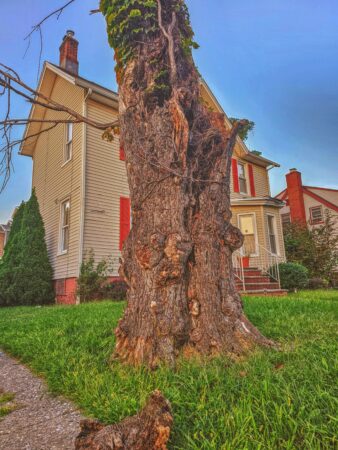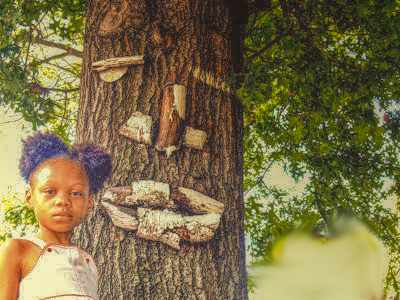THE OBSERVATION BOOTH

OP / ED & PHOTOS BY ANDREA DIALECT
EGOS & SYSTEMS
The professional title for professionals who work with dying or diseased trees is Arborist or Tree Surgeon.
Hello there, I promise I had no intention of getting on my soapbox again this week. But I was driving, minding my business, as I mentioned in the adventure article weeks ago, when the image before me once again summoned my attention. Then, my guide reminded me of my last encounter, one of many kinds I’ve been noticing all over town, often in the most unexpected places, just like the one in the image affixed here.
The first time I stumbled upon it, I stood there, consumed by sheer curiosity. When I saw it, it seemed to have an affirmative and bold presence – such death, yet such a living testament. Soon after, that still voice, my guide that I’ve come to know so well interjected, speaking sparingly this time, but the words have echoed in my mind ever since. Every time I come across any tree that has succumbed to death, those words return: “The Family Tree.”
Look at the image of that tree. Really look. Do you see it? I’m afraid this picture falls short when it comes to truly capturing the experience of this living testament, which I believe reflects what is rapidly becoming our collective reality. For me, it has become a constant reminder – my tree of life – because it forces me into action, what a grim reality.
Because I want you all to experience this phenomenon as I have, I invite you to join this Andrea Dialect Experience. Participate with me in this Scavenger Hunt and witness what this tree, and soon after all such trees have to tell us. (Info below)
You will also find my piece called “Autumn” included here. The character represents the voice of my late grandmother Bessie Mae Robinson. Perhaps you can also partake in the challenge of reading the script in a second person’s voice. That of an Elder woman. It really adds to the experience. Anything that has not been included in this article be certain to go to localtalkweekly.com and read it in its entirety. You’ll want to read it all!

TREASURE TROVE
GPS Scavenger Hunt
Getting in the Car: Roll the windows down when you reach the location. Taking your time, be observant, and reflect on the significance of what you’re about to find. Let this be a moment to feel the world beyond the car.
Listen to the sounds around you – the rustling of leaves, the birds, and the distant hum of life. These are the echoes of generations before us, those whose roots run deep, just like the tree you are about to find.
Drive by or circle the block a few times. Park your car a short distance from the tree if you’d like. Walk slowly, notice how the ground feels beneath your feet – solid, like the foundation of family.
Look at the tree. What stories does it tell? Imagine all the people who have stood in our world as you are now, looking up at its void of branches.”
Logistics
- Location: East Orange, Dodd Street
- Time Limit: Depends on the distance
- Group Size: Individually or in a group
- Instructions: Be safe, respect property, and the goal of the scavenger hunt.
The Clues
- First Clue (Starting Point: Around the corner from New Jersey Transits Bus Garage.
- Subsequent Clues: You’ll find the tree right on the corner directly across the street from “The Living Water Church
- Use of GPS or Maps: Use it if you’re not familiar with East Orange, NJ.
The Narrative
Humanity is fast becoming a dying breed.
“Step out of your car and pause for a moment. Look around, breathe in the air, and take in your surroundings. With each step, think about your own roots, your family history, and the things that connect you to the world. As you walk towards the tree, imagine that you are walking toward a deeper understanding of who you are.
“Stepping out of the car represents stepping into a new understanding or awareness. Use all senses as you approach the tree. take a moment of silence, reflect on the journey and the metaphor of the tree as family. TAKE PHOTOS AND SHARE THEM WITH US… ENJOY”
AUTUMN
No longer does the gentle breeze of autumn soothe me. Nor do I any longer take in air, inhaling the sweet of change. Change, such change, for there was a time when the face of autumn could paint a picture of such beauty. But now, now autumn has come forth anew.
Although it hadn’t happened all at once, it is here. It has crept upon us as a thief does, and I cannot welcome this. Simply, what is our fate if in such trying times upon the changing of seasons we cannot depend? Autumn has removed itself from its place, and it has come inside to dwell. Fall has come upon this once deeply rooted, once strong family, and it is as an evergreen no more. Winter nears us, and if his visit greets us with great force, we’d likely perish. For the need, the need for harvest is no more. For when the strong winds blew, rightfully returning those of ripened age back to the earth from whence they came, their last, their last autumn was that of our own. How deeply saddened my heart.
Understand that the passing of our strongest has caused the bough to break, and now ignorance shades us from the sun, and our branches now bow as that of a willow tree, a dying willow that weeps. Though it hadn’t happened all at once, it is here. If we do not lift our eyes from weeping, lift our heads from mourning, lift our eyes from weeping and begin to till and toil, and with our eyes towards the heavens, repent, praying also that once again we are granted a woven kinship and life, because if we don’t, just as fast as a forest fire sweeps through a forest full of life, just as the same, none being spared – the family, the family shall surely die.
DID YOU KNOW THAT ….
A tree has several key parts, each with specific functions essential to its growth and survival. These parts include:
- Roots – Anchor the tree in the soil and absorb water and nutrients.
- Trunk – Provides support and transports water, nutrients, and sugars between the roots and leaves. Bark – The outer protective layer of the trunk that shields the tree from damage and disease.
- Branches – Extend from the trunk and support the leaves, flowers, and fruit.
- Leaves – The site of photosynthesis, where sunlight is converted into energy (sugars) for the tree.
- Crown – The top part of the tree, consisting of branches and leaves; it spreads out to capture sunlight.
- Twigs – Smaller branches that support the leaves and new growth.
- Cambium – A thin layer of living cells under the bark that produces new growth for the tree, including wood and bark.
- Sapwood (Xylem) – The younger, outer wood that transports water and nutrients from the roots to the leaves.
- Heartwood – The older, inner wood that provides structural strength but no longer transports water.
- Flowers – The reproductive structures of the tree, leading to the production of seeds.
- Fruit/Seeds – Contain the seeds for reproduction, ensuring the growth of new trees.
- Each part plays a vital role in maintaining the overall health and life cycle of the tree.
Plant pathology is the scientific study of plant diseases caused by pathogens (such as fungi, bacteria, viruses, and nematodes) and environmental conditions (such as drought, pollution, or nutrient deficiencies). It involves understanding how diseases develop in plants, how they spread, and what effects they have on plant growth, health, and yield.
Plant pathologists work to:
- Identify plant diseases and their causal agents.
- Understand the mechanisms by which pathogens infect plants.
- Study plant immune responses and resistance to disease.
- Develop methods for disease prevention and control, such as breeding disease-resistant plants, using pesticides, or implementing better agricultural practices.
- Investigate environmental stresses like poor soil conditions, pollution, or drought that can make plants more susceptible to diseases.
This field plays a crucial role in agriculture, forestry, and ecosystem management by ensuring healthy plant growth and preventing economic losses due to crop failures or tree mortality.
The professional title for people who work with dying or diseased trees is Arborist or Tree Surgeon.
Arborists are trained in the care and maintenance of trees, including diagnosing and treating diseases, managing pests, and addressing tree health issues. They provide services such as pruning, fertilizing, and removing dead or hazardous trees.
Tree Surgeons often specialize in more hands-on work, such as cutting back or removing diseased or dying branches, but their expertise can overlap with arborists, particularly in the context of tree health and preservation.
Some arborists may also specialize in plant pathology, focusing on diagnosing and managing tree diseases.
DO YOU KNOW ANY OF OUR COMMUNITY ACCESS CONTRIBUTORS?
- IF SO LET THEM KNOW THAT THEY’VE MADE THE CUT AND THEY ARE THE TALK OF LOCAL TALK THIS WEEK!
- PASS IT ON!
- LIKE, COMMENT, SHARE!


